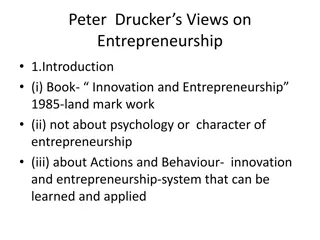Exploring Business Models in Entrepreneurship for Computer Science
Today's lecture covered the fundamentals of business models in entrepreneurship, emphasizing the importance of value creation and value capture. It discussed various types of business models, including the Up-Front Charge Model and the Transaction Fee Model, highlighting their respective features and implications for revenue generation. Understanding different business models is crucial for entrepreneurs looking to monetize their products or services effectively.
Download Presentation

Please find below an Image/Link to download the presentation.
The content on the website is provided AS IS for your information and personal use only. It may not be sold, licensed, or shared on other websites without obtaining consent from the author. Download presentation by click this link. If you encounter any issues during the download, it is possible that the publisher has removed the file from their server.
E N D
Presentation Transcript
Entrepreneurship for Computer Science CS 15-390 Business Models- Part I Lecture 6, January 23, 2018 Mohammad Hammoud
Today Last Session: Beachhead markets & revenue projections (continued) Today s Session: Business models- Part I Announcements: PS1 is due today by midnight CP1 is due on Feb 27 by midnight
Value Creation vs. Value Capture Amount of time spent on value capture innovation Amount of time spent on value creation innovation Methinks you need to get things more in balance!
Business Models A business model is a value capture framework via which you monetize your product or service based on the value it creates for your customers Hence, it is value-based and NOT cost-based There is no one universally right business model, as it depends on your specific situation It helps to think through some common types of business models, hence, we will discuss a taxonomy of famous models
The Up-Front Charge Model A customer pays a large one-time up-front amount of money to obtain a product/service The payment might come out from a capital budget , which might necessitate a long and formal approval process (especially, if the end-user is not the economic-buyer) Typically, the customer can also secure ongoing upgrades or maintenance of the product for a recurring fee The fee might come out from an operating budget The model can serve in a large up-front infusion of cash to your business, but might impact your ability to secure a good enough recurring revenue stream
The Transaction Fee Model Online retailers often pay or receive a commissionfee for referrals that lead to sales E.g., Ebay receives a fee from each successful auction, paid by the seller This model is similar to how credit/debit card companies work, where a percentage of each transaction goes to the credit/debit card company
The Transaction Fee Model Issuer Authorized Alice gets a Credit Card from Bank A Bank C Bank A Processor MasterCard Acquirer Authorize Generic E-commerce Site S Alice buys an item with a value of $100 from Site S using her Credit Card Bank B Processor Bank D Visa Bank E
The Transaction Fee Model Issuer Bank A cuts an interchange fee (say, $1.6) and pays the rest to the MasterCard company Bank C Bank A Processor MasterCard cuts a commission fee (say, $0.1) and pays the rest to Bank B MasterCard Acquirer Site S charges the actual seller (assuming S does not own the inventory) a commission fee (e.g., 5- 15% of the transaction cost) Generic E-commerce Site S Bank B Processor $98 Bank D Visa Bank B cuts an interchange fee (say, $0.3) and pays the rest to Site S Bank E
The Parking Meter Model Parking meters charge low hourly parking rates (e.g., $0.25) This seems to defy the logic of having large and expensive parking meters (let alone official people collecting quarters) However, the city charges high for parking tickets that become even higher if someone does not pay in an X (e.g., 10) number of days No wonder cities have so many parking enforcement people! Is not this aspect of the model akin to the one used by credit/debit card companies against defaulters? Caveat: loyal customers might become alienated by late fees (discovered by Blockbuster and precluded by Netflix)
The Usage-Based Model The usage-based model is similar to how electric and water utilities are metered (i.e., pay-as-you-go a service fee) E.g., Cloud Computing services like Amazon EC2 Conventional Computing Conventional Computing Conventional Computing Conventional Computing Conventional Computing Conventional Computing Cloud Computing Cloud Computing Cloud Computing Cloud Computing Cloud Computing Cloud Computing Buy and own (hardware, system software, etc.)- Pay $$$$ (High Cost) etc.)- Pay $$$$ (High Cost) etc.)- Pay $$$$ (High Cost) etc.)- Pay $$$$ (High Cost) etc.)- Pay $$$$ (High Cost) etc.)- Pay $$$$ (High Cost) Buy and own (hardware, system software, Buy and own (hardware, system software, Buy and own (hardware, system software, Buy and own (hardware, system software, Buy and own (hardware, system software, Subscribe (for free) Subscribe (for free) Subscribe (for free) Subscribe (for free) Subscribe (for free) Subscribe (for free) Install, configure, test, verify, evaluate, and manage- Pay $$$$ (High Cost) manage- Pay $$$$ (High Cost) manage- Pay $$$$ (High Cost) manage- Pay $$$$ (High Cost) manage- Pay $$$$ (High Cost) manage- Pay $$$$ (High Cost) Install, configure, test, verify, evaluate, and Install, configure, test, verify, evaluate, and Install, configure, test, verify, evaluate, and Install, configure, test, verify, evaluate, and Install, configure, test, verify, evaluate, and Use Use Use Use Use Use Use Use Use Use Use Use Pay $ for what you use Pay $ for what you use Pay $ for what you use Pay $ for what you use Pay $ for what you use Pay $ for what you use
The Usage-Based Model The usage-based model is similar to how electric and water utilities are metered (i.e., pay-as-you-go a service fee) E.g., Cloud Computing services like Amazon EC2 The service feeis typically constant and NO up-front (or base or subscription) fee is incurred This makes the model flexible, but unpredictable! The model provides control to customers over their expenses because they only pay for the amount of resources they use (rather than paying for extra capacity they do not use)
The Cell-Phone Model This is a variant of the usage-based model Pay a base fee in exchange for a certain amount of usage Pay additional fee (often at much higher marginal rates) if you use more than your allotted amount Both sellers and buyers get predictability from the base charge Customers get flexibility via being able to obtain additional resources if needed (although at a somehow large cost)
The Subscription or Leasing Model A customer pays a subscription fee at the end of every predetermined time period (e.g., bi-weekly, monthly, annually, etc.) for obtaining your service or product E.g., Netflix Typically, you can extract higher payments over shorter periods of time (e.g., monthly vs. yearly) The model provides flexibility to customers (assuming they can unsubscribe at anytime) with predictable, fixed payments for businesses over agreed-upon periods of time
The Licensing Model You can license your product (or your intellectual property if it is very strong) and receive a royalty on sales (dynamic revenue) or a regular fixed amount of money (static revenue) Royalty rates are typically one-twentieth or less of the revenue per sale (5% royalty is about the best you can hope for) Consequently, you avoid making big investments in production and distribution capabilities But, you would rely on other companies to sell your product This limits your ability to continually invent (you cannot learn from end-users!)
The Consumable Model A customer pays for your product, but also pays ongoing fees for using it E.g., The razor-razorblade model of Gillette E.g., HP printers (actually almost all if not all HP s profit on printers comes from selling inkjet cartridges) The model allows you to: Reduce the friction to capture new customers Get some up-front cash Secure a recurring revenue stream
The Upsell Model You can sell your product at a very low margin, but increase your overall margin via selling add-on products and/or charging for necessary future services E.g., Consumer electronics (e.g., cameras) and automobiles (add-ons include warranty extensions, accessories, etc.) Attractive for customers Initially, they might not pay much Profitable for businesses They usually incur large margins on add-ons
The Freemium Model A customer pays zero money for a basic functionality of your product, but pays for obtaining premium features Many people can try your product However, will these people (they are not customers until they pay) pay for the extra features available in your product? Caveat: If people do not pay for your extra features, you do not have a business (recall the solo condition for having a business) Is freemium a business model? Can you not offer premium features and make money through a third party?
Next Class Business Models- Part II Pricing Frameworks























